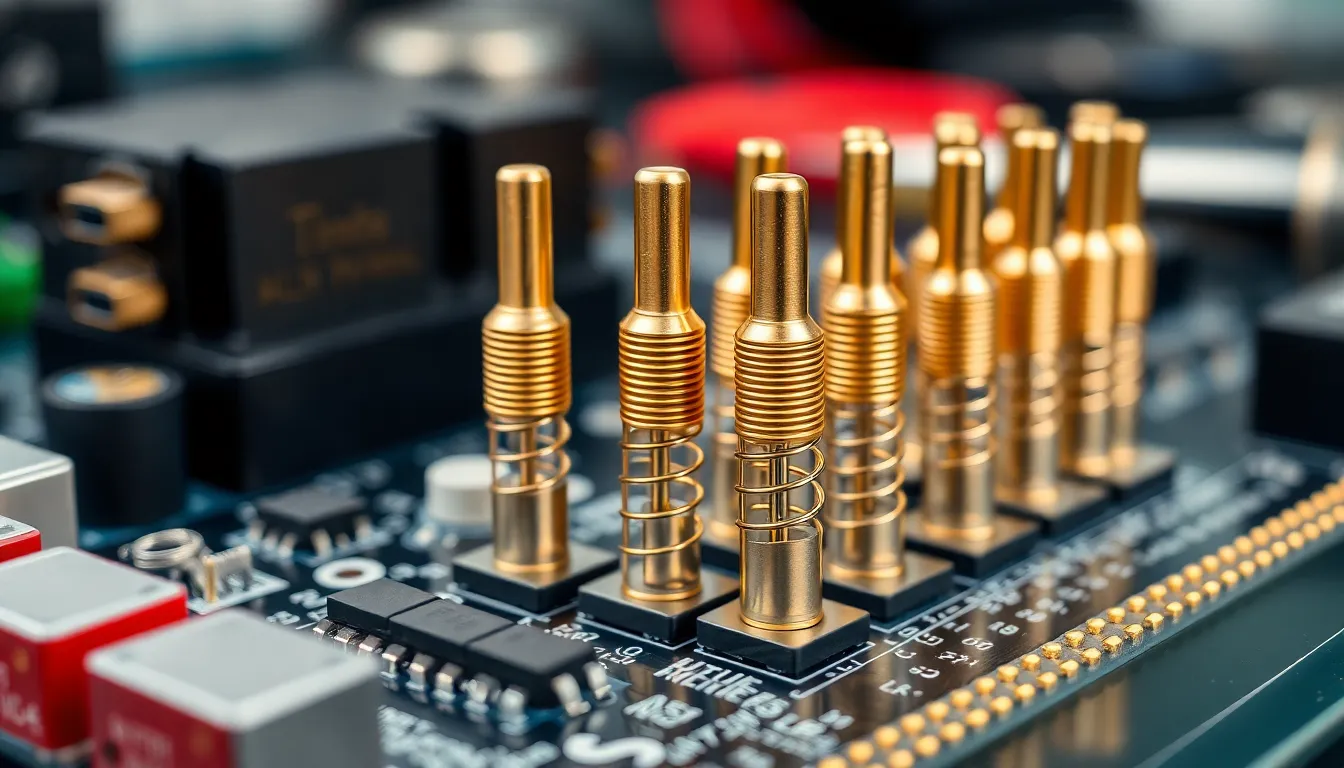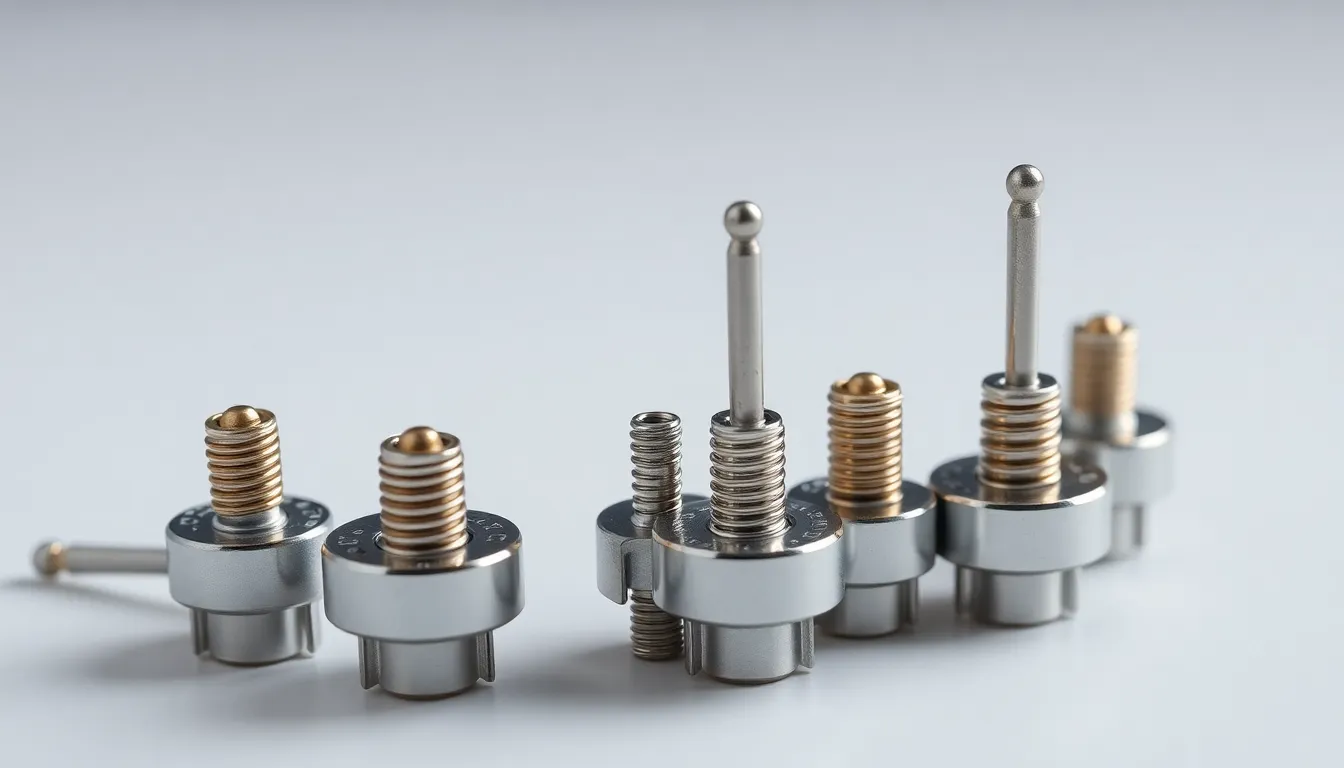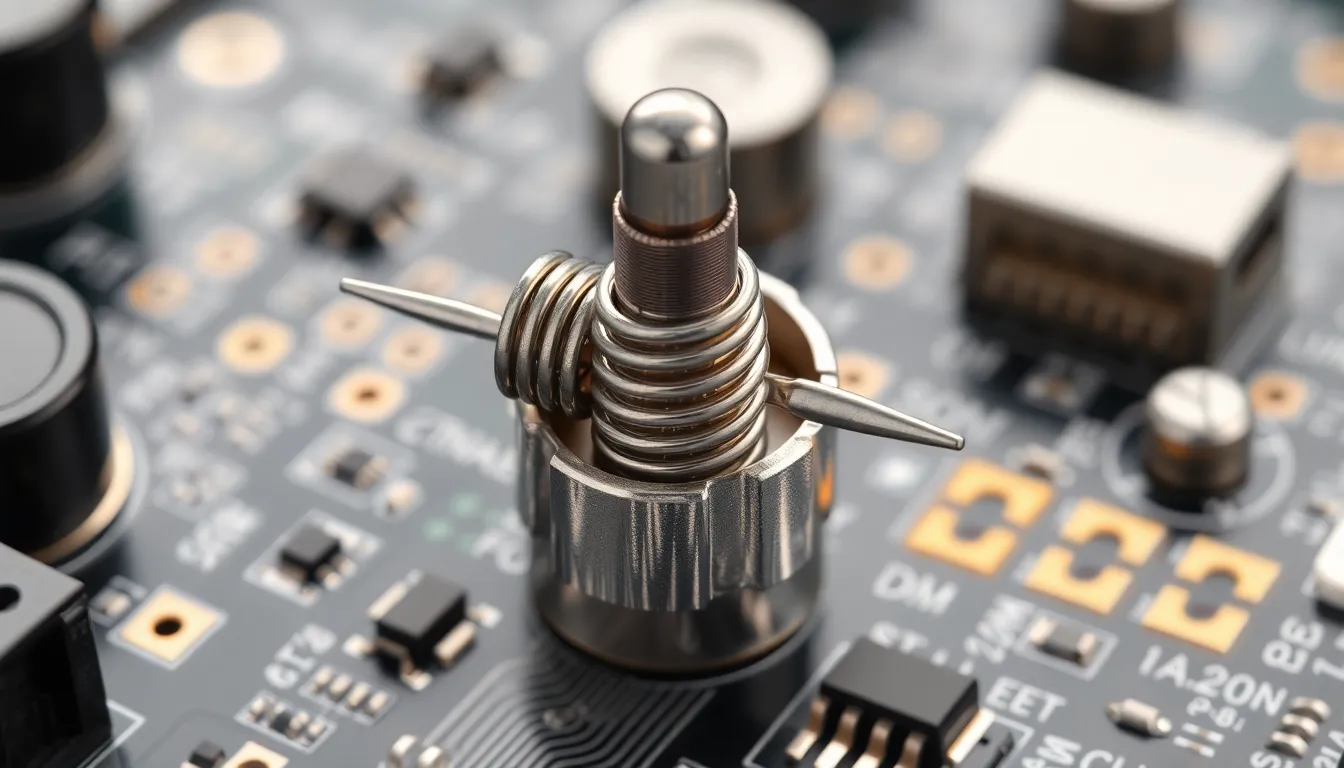
How Do Pogo Pins Work: Structure, Mechanism, Applications, and Benefits in Electronics
Key Takeaways
- Pogo pins are spring-loaded connectors that provide reliable, temporary electrical connections in devices ranging from smartphones to industrial equipment.
- Their unique design—comprising a plunger, spring, and barrel—ensures stable power and signal transfer even under frequent connections and mechanical stress.
- High-quality construction materials, such as gold-plated contacts, offer excellent conductivity, corrosion resistance, and longevity.
- Common applications include charging docks, test equipment, PCBs, medical devices, and automated production lines that require robust, repeatable connections.
- Key benefits of pogo pins include high-cycle durability, shock resistance, compact size, and consistent connectivity, but they may require periodic maintenance and are limited in current capacity compared to other connectors.
Pogo pins might look simple, but they’re actually powerhouses in modern electronics. These tiny spring-loaded connectors create quick and reliable electrical connections in everything from smartphones to industrial machinery. Their clever design allows devices to connect and disconnect easily while keeping a steady flow of power or data.
Many electronics enthusiasts and engineers choose these durable and efficient connectors for testing and charging solutions. A quality Pogo Pin Manufacturer creates these clever components that make our everyday gadgets work better. Understanding how these handy connectors function opens up new possibilities for anyone interested in electronics or product design.
What Are Pogo Pins?
Pogo pins are cylindrical spring-loaded electrical contacts designed for reliable temporary connections in electronic devices. Application examples include test equipment, docking stations, battery chargers, medical devices, and mobile phones. Each pogo pin uses an internal spring mechanism to maintain consistent contact force between two electronic components, ensuring stable power or data transfer even if subjected to vibration or minor misalignment.
Manufacturers assemble pogo pins with three main parts: a plunger, a barrel, and a spring. The plunger moves inside the barrel when pressed, while the spring provides the necessary force to push the plunger outward. Specifications like stroke length, plating material (often gold for corrosion resistance), and contact resistance affect performance and product compatibility.
Promax in China produces custom pogo pins and spring-loaded connectors to meet diverse industrial requirements. Factories use automated assembly lines and precise quality control, supporting product applications for consumer electronics, aerospace systems, and medical devices. Engineering teams at Promax design connectors for high-cycle durability, consistent electrical performance, and integration into compact device footprints. Demand for dependable pogo pins continues to grow as devices require faster data transfer and more efficient power delivery.
The Basic Structure of Pogo Pins

Pogo pins feature a compact mechanical design that ensures reliable connections in electronics. Their structure directly impacts electrical performance and contact stability during repeated operations.
Main Components of a Pogo Pin
Each pogo pin consists of three primary components:
- Spring: Delivers the necessary contact force. Springs use conductive alloys for efficient current flow and are engineered for durability over thousands of cycles.
- Plunger: Moves outward when compressed and contains the contact tip, ensuring dependable engagement with mating surfaces.
- Barrel (Housing): Encases the spring and plunger, maintaining mechanical alignment and insulation. The barrel design prevents misalignment and contact slippage.
Promax, a leading manufacturer in China, customizes plunger profiles and spring tensions for specific use cases in consumer electronics and medical devices.
Materials Used in Pogo Pin Construction
Pogo pin construction uses quality conductive metals:
- Base Metals: Engineers select brass, copper, nickel, or bronze to maximize conductivity and minimize signal loss. For example, copper or nickel alloys are common in medical device pins for stable power delivery.
- Contact Plating: Surfaces are often plated with gold, palladium, silver, or nickel for corrosion resistance and long-term reliability. Gold-plated pins, used in mobile device charging ports, support high-cycle operation and low contact resistance.
- Additional Materials: Non-conductive materials in the barrel may provide structural support or environmental protection as needed.
Promax applies custom plating thickness and base metals according to client requirements for data transfer speed, durability, and application environment.
How Do Pogo Pins Work?

Pogo pins function as spring-loaded connectors that maintain stable electrical pathways under high-cycle use. Engineers and product designers rely on their mechanical precision for power and data transmission in compact assemblies.
The Spring Mechanism Explained
A pogo pin uses a plunger, barrel, and spring to create a dynamic electrical contact.
- The plunger rests outward when no force applies, due to the spring inside the barrel.
- When a testing jig or device applies force, the spring compresses, and the plunger tip moves forward to touch a mating pad or surface.
- The internal spring stores force and then helps maintain contact pressure as long as the pin stays engaged.
- The plunger retracts to original position when pressure releases, protecting assemblies from wear and misalignment.
Manufacturers like Promax in China design spring mechanisms to support cycle counts over 50,000 insertions and resist shock or vibration during operation.
Electrical Contact and Conductivity
Pogo pins enable efficient power and signal transfer through conductive metal construction.
- Gold, copper, or palladium platings on the contact point resist oxidation and maintain consistent conductivity.
- The plunger delivers a low-resistance pathway to minimize voltage loss during contact.
- Promax engineers optimize the barrel and plating to handle currents up to 5A in medical and industrial devices.
- The spring’s force ensures reliable engagement on uneven or mobile surfaces, absorbing shock and preventing electro-mechanical failure.
Pogo pins’ material choices and manufacturing tolerances ensure plug-and-play performance across fast-charging, data transfer, and testing applications.
Common Applications of Pogo Pins
Pogo pins function as reliable connectors wherever temporary and repeatable electrical contacts are essential. Promax manufactures spring-loaded pins and magnetic connectors in China for high-volume and custom applications where durability and consistent performance are critical.
Use in Electronic Devices
Engineers integrate pogo pins into consumer electronics for charging, signal transfer, and device interfacing. Smartphones, tablets, and wireless headphones use pogo pins for battery charging and communication connections. Testing and programming interfaces on printed circuit boards (PCBs) benefit from pogo pins due to their quick-connect design and high insertion cycles. Promax supplies pogo pin arrays and contact probes with custom force ratings and plating finishes, supporting battery connectors, test points, and docking stations. Pin designs from Promax enable reliable retention and alignment in mobile devices, ensuring stable data transfer and fast-charging performance.
Industrial and Testing Equipment
Manufacturers prefer pogo pins in automated test equipment (ATE), fixture interfaces, and production lines for in-circuit testing (ICT) or functional verification. Automotive electronics, telecommunications panels, and medical instruments employ pogo pins for robust, vibration-resistant contact under repetitive use. Promax designs spring-loaded connectors for high-cycle mechanical actuation and resistance to shock, supporting more than 50,000 mating cycles in factory and field environments. Custom assemblies from Promax provide tight tolerances in pin travel, spring force, and current rating, enabling dependable signal integrity and low-resistance contact for test sockets, programming interfaces, and industrial sensor modules.
Advantages and Limitations of Pogo Pins
Pogo pins deliver consistent, temporary connections that meet high mechanical cycle demands in electronics. Promax in China engineers pogo pins with robust construction, enabling efficient integration into compact devices and automated test systems.
Benefits Over Other Connectors
- High-cycle durability: Pogo pins withstand more than 50,000 insertion cycles, meeting the requirements of battery charging docks and test fixtures.
- Shock and vibration resistance: The internal spring mechanism absorbs impact forces, protecting data and power paths in mobile or industrial environments.
- Compact footprint: The small form factor allows high-density placement in smartphones, tablets, and miniaturized medical equipment.
- Fast assembly and disassembly: Floating or self-aligning tips streamline device manufacturing, supporting automated test and production lines.
- Consistent connectivity: The self-cleaning wiping action of the plunger reduces oxidation risk with gold-plated tips, ensuring reliable signal integrity in Promax connectors.
Potential Drawbacks to Consider
- Contact wear: Repeated mechanical cycling gradually wears plunger surfaces and mating contacts, limiting lifespan in high-frequency test setups.
- Oxidation exposure: Metal tips exposed to air risk surface oxidation, which increases electrical resistance and affects critical test or charging applications.
- Lower current rating: Most pogo pins handle up to 5A, restricting use in high-current systems compared to stamped or soldered alternatives.
- Cost: Precision-manufactured pogo pins, especially with gold plating or custom designs from suppliers like Promax, increase connector costs for consumer and enterprise applications.
- Maintenance requirements: Regular inspection or cleaning becomes necessary in environments with high humidity or contaminant exposure to maintain electrical performance.
About Promax
Promax specialises in the manufacturing of high-quality pogo pins, spring-loaded connectors, and magnetic connectors for a wide range of industries, including consumer electronics, aerospace, and medical.
With over 15 years of expertise, Promax, under the management of Gavin, offers customizable solutions tailored to the unique needs of their clients. The company is committed to delivering competitive pricing and internationally certified quality standards, ensuring reliability and excellence in every product they provide.
Contact:
Gavin, Manager
Phone: +86 189 2659 5104
Email: [email protected]
Website: www.promaxpogopin.com
Frequently Asked Questions
What are pogo pins?
Pogo pins are small, spring-loaded connectors used to create reliable temporary electrical connections in electronic devices. They consist of a plunger, barrel, and spring, and are commonly found in test equipment, chargers, and other consumer electronics.
How do pogo pins work?
Pogo pins use a spring-loaded mechanism that allows the plunger to compress when pressed against a mating surface, maintaining stable electrical contact. When the pressure is released, the plunger retracts, minimizing wear and ensuring repeated use.
Where are pogo pins commonly used?
Pogo pins are used in smartphones, tablets, test equipment, battery chargers, medical devices, docking stations, and various industrial tools requiring fast, reliable connections.
What materials are commonly used to make pogo pins?
Pogo pins are usually made with conductive base metals like brass or copper, and are often plated with gold or palladium to ensure corrosion resistance and improved electrical performance.
What are the main advantages of using pogo pins?
The main benefits include high durability for repeated use, resistance to shock and vibration, compact size, easy assembly and disassembly, and reliable, self-cleaning contacts that maintain connectivity.
Do pogo pins have any limitations?
Yes, limitations include potential contact wear over time, lower current ratings compared to some connectors, possible oxidation, higher costs for precision designs, and maintenance needs in harsh environments.
How long do pogo pins typically last?
Well-designed pogo pins, like those made by Promax, can withstand over 50,000 insertion cycles while maintaining reliable performance in most applications.
Can pogo pins handle fast charging and high data transfer?
Yes, modern pogo pins are specifically designed for efficient power delivery and fast data transfer, with some models capable of handling currents up to 5A to support fast-charging applications.
Are there custom options available for pogo pins?
Yes, manufacturers like Promax offer custom pogo pin designs tailored to specific needs, including different shapes, sizes, materials, and performance requirements for various electronic applications.
What makes Promax pogo pins stand out?
Promax pogo pins are recognized for their high-cycle durability, consistent electrical performance, customizable features, and their ability to meet stringent demands for speed and reliability in modern electronics.
